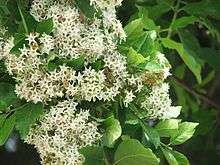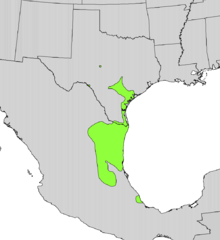Ehretia anacua
Ehretia anacua is medium-sized tree found in eastern Mexico and southern Texas in the United States. It is a member of the borage family, Boraginaceae.[1] One of its common names, anacua, is derived from the Mexican Spanish word anacahuite, as is that of the related Cordia boissieri, the anacahuita.[2] That word in turn is derived from the Nahuatl words āmatl, meaning "paper," and cuahuitl, meaning "tree,"[3] possibly referring to the bark. It is also known as knockaway, a corruption of anacua, and sandpaper tree.[2] Alternate spellings are anaqua and anachua.[4]
| Ehretia anacua | |
|---|---|
 | |
| Scientific classification | |
| Kingdom: | Plantae |
| Clade: | Tracheophytes |
| Clade: | Angiosperms |
| Clade: | Eudicots |
| Clade: | Asterids |
| Order: | Boraginales |
| Family: | Boraginaceae |
| Genus: | Ehretia |
| Species: | E. anacua |
| Binomial name | |
| Ehretia anacua | |
 | |
| Natural range | |
| Synonyms | |
Description
Anacua reaches a height of 20–45 ft (6.1–13.7 m)[2] and a diameter of 0.3 m (0.98 ft),[5] often producing suckers or multiple trunks.[2] The bark is reddish-brown to gray with narrow furrows and peeling scales. The dark green leaves are 3–8 cm (1.2–3.1 in) and 2–4 cm (0.79–1.57 in) wide and elliptical or ovate. Their upper surfaces are remarkably rough, feeling like low-grade sandpaper.[5] Anacua is a partial evergreen, replacing some of the leaves in early spring. Abundant white flowers[2] form in panicles or cymes[6] 5–7.5 cm (2.0–3.0 in) in length at the ends of twigs,[5] making trees appear to be covered in snow when in bloom from spring to summer.[2] Flowers are 8 mm (0.31 in) wide and have 5 corolla lobes. The fruits are spherical[5] drupes[7] 8 mm in diameter and yellowish-orange.[5] The drupes contain two stones, each with two seeds.[5] In addition to being edible by humans, the drupes are eaten by mammals and birds[2] such as the clay-colored thrush.[8] The lifespan of an Anacua is at least 50 years.[9]
Habitat
Anacua is found on dry hillsides as a shrub, but reaches tree size in the moist soils of riparian zones and floodplains. It can be found at elevations from sea level to 1,000 ft (300 m).[5]
Ecology
The leaves of E. anacua are the sole food source of the Texas tortoise beetle (Coptocycla texana).[10]
References
| Wikimedia Commons has media related to Ehretia anacua. |
| Wikispecies has information related to Ehretia anacua |
- "Ehretia anacua". Germplasm Resources Information Network (GRIN). Agricultural Research Service (ARS), United States Department of Agriculture (USDA). Retrieved 2009-11-25.
- "Ehretia anacua (Teran & Berl.) I.M. Johnston". Native Plant Information Network. Lady Bird Johnson Wildflower Center. Retrieved 2009-12-10.
- Riess, Elizabeth M. (1958). The Garden of Chaparral: Plants of the Lower Rio Grande Valley. Vantage Press. p. 127.
- "Anacua". Trees of Texas. Texas A&M Forest Service. Retrieved 19 November 2017.
- "Anacua Ehretia anacua". Field Guides. eNature. Archived from the original on 2011-06-14. Retrieved 2009-09-29.
- Lehman, Roy; Ruth O'Brien; Tammy White (2005). Plants of the Texas Coastal Bend. Texas A&M University Press. p. 111. ISBN 978-1-58544-408-3.
- Vines, Robert A. (1984). Trees of Central Texas. University of Texas Press. p. 349. ISBN 978-0-292-78058-3.
- Adams, Mark Thomas; Brush Freeman (2003). Chasing Birds Across Texas: a Birding Big Year. Texas A&M University Press. p. 36. ISBN 978-1-58544-296-6.
- "A Guide to Growing Healthy Trees in the Lower Rio Grande Valley of Texas" (PDF). Valley Proud Environmental Council. 2007. Archived from the original (PDF) on 2011-07-28. Retrieved 2009-12-10.
- Taber, Stephen Welton; Scott B. Fleenor (2005). Invertebrates of Central Texas Wetlands. Texas Tech University Press. pp. 147–148. ISBN 978-0-89672-550-8.
External links
- "Ehretia anacua" (PDF). Digital Representations of Tree Species Range Maps from "Atlas of United States Trees" by Elbert L. Little, Jr. (and other publications). United States Geological Survey.